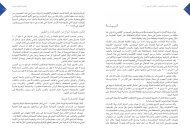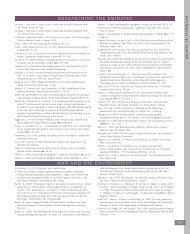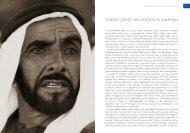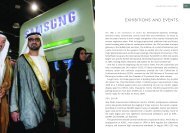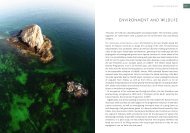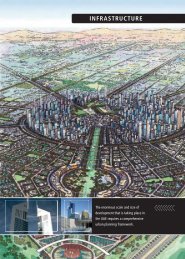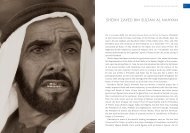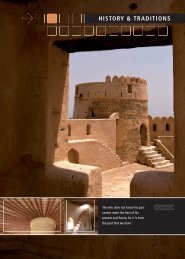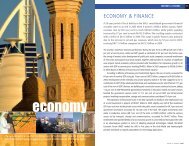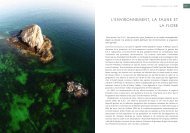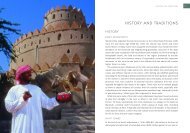Create successful ePaper yourself
Turn your PDF publications into a flip-book with our unique Google optimized e-Paper software.
164UNITED ARAB EMIRATES YEARBOOK 2006<strong>ECONOMIC</strong> <strong>DEVELOPMENT</strong>165The <strong>UAE</strong>’s natural attributes form a key part of tourism development strategythroughout the Emirates. Ecotourism is one of many niche markets receivingattention in 2005. The <strong>UAE</strong> aims to attract birdwatchers, scientists, researchers andstudents to visit areas of special natural beauty and interest, such as the Ra’s al-KhorWildlife Sanctuary located at the head of Dubai Creek. Three watchtowers havebeen provided close to a feeding ground for large numbers of flamingos, otherwading birds and a host of migratory species. Other sanctuaries have been createdin various parts of the country.Each emirate has its own attractions. Sharjah has built a reputation for its culturalpreservation and its special interest in education, the arts and heritage. Projectssuch as authentic building and souq preservations, a large number of museumsand galleries, together with its special Natural History Museum, Desert Park andArabian Wildlife Centre have drawn on natural assets and created a unique seriesof experiences that visitors can enjoy, regardless of where they are staying withinthe <strong>UAE</strong>. In addition, Sharjah has recently strengthened efforts to promote tourism.Part of the emirate’s attraction is its shopping facilities, with six major shoppingmalls, including four souqs.Ra’s al-Khaimah is planning new hotels and two or three new golf courses.One of these, ‘The Cove’, will be on more than 50 acres of beachfront property,including 134 Nubian style furnished residences. Its target markets are especiallyItaly, Germany, Switzerland and the UK. Many of the new projects are beingdeveloped near the new Emirates Highway which is cutting travel time betweenDubai and Ra’s al-Khaimah to 45 minutes.Ajman has four hotels with more than 565 rooms, while Umm al-Qaiwain hasareas of special scientific and historic interest.Fujairah, situated on the <strong>UAE</strong>’s East Coast, has a number of special attractions,including wonderful beaches. The first international hotel to open on the EastCoast in over two decades is award-winning Le Meridien Al Aqah Beach Resortwhich has been very successful in generating renewed interest in Fujairah andis a catalyst for further development of the sector. On weekends, the resort has100 per cent occupancy. Agreements were recently signed with local and foreigninvestors for the construction of a further five hotels in the same area.Future investments in tourist projects are likely to be significant, throughout the<strong>UAE</strong>. Abu Dhabi alone plans to spend at least Dh40 billion between 2005 and 2015.AGRICULTUREThe agriculture, fisheries and livestock sector contributed 2.6 per cent to GDPin 2004 with a value of Dh10.1 billion. The <strong>UAE</strong> exports dates to Japan, Indonesiaand Malaysia, while flowers are sent to other GCC countries, Lebanon, Australia,Britain and Japanese markets. Thousands of hectares of palm trees, woodlandsand green belts have been planted in the country. Date-palm cultivation plays akey role in turning large portions of the desert into green oases. Over 40 milliondate palms, of which 16 million line the roads, have been planted in the <strong>UAE</strong>.It is a surprising fact that a country known for its vast desert, exceptionally lowand unpredictable rainfall and, at times, searing heat, can also sustain a vibrantagricultural sector. Whilst the huge growth in food production since the early 1970shas been correctly attributed to the leadership, much of it by personal exampleof the late Sheikh Zayed, cultivation of a few key plants, raising of livestock andfishing have been essential survival skills of people living in this extremely aridregion for millennia. Small-scale farming based upon exploitation of undergroundwater resources began in desert oases and mountain valleys at least 5000 yearsago, but the lack of rainfall made large scale agriculture impossible. Today, Emiratisstill have a strong connection with the earth, whether that encompasses the sandsof the Empty Quarter or the isolated patches of fertile soil that form their oases.In the early days of Sheikh Zayed’s drive towards self-sufficiency in certain fooditems, agricultural advisers were discouraging and highly sceptical. But SheikhZayed, refusing to be discouraged, took a multi-pronged approach that would notaccept failure as an option. Water, of course, was at the core of this effort and heestablished a major programme of groundwater exploration as well as rehabilitationof ancient falaj irrigation and distribution channels. Later, he put money earnedfrom oil into building dams and desalination plants. But water was not all that ittook. The Ministry of Agriculture set about establishing experimental farms to testa wide range of crops and growing systems, and Emiratis were given land to createtheir own farms with substantial government assistance. When we look at themassive achievements of this sector it is important to understand that it has notcome about by chance, or without a serious effort by both government and people.Today, despite rapid population growth, the <strong>UAE</strong> is 100 per cent self-sufficientin dates and fish and grows 58 per cent of its vegetable needs. Meat and poultryproduction provide 31 per cent and 17 per cent respectively of requirements.The country produces 83 per cent of its daily consumption of fresh milk and 39per cent of national demand for eggs.Modern irrigation techniques and water from deep artesian aquifers and fromdesalination has made it possible for large areas to be cultivated. There are nowmore than 100,000 hectares of cultivated land, producing a range of crops, includingsalad vegetables, potatoes, fruit and fodder, as well as flowers, grown mainly forexport to Europe. In traditional mountain farms, production of tropical fruits likepapaya, citrus and tobacco continues. The Government supports agriculture throughpreparation of land for farms which are distributed free to citizens, and follows thisup with a free agricultural extension service. Farmers are also offered a guaranteedprice for produce and subsidised machinery and fertilisers.



